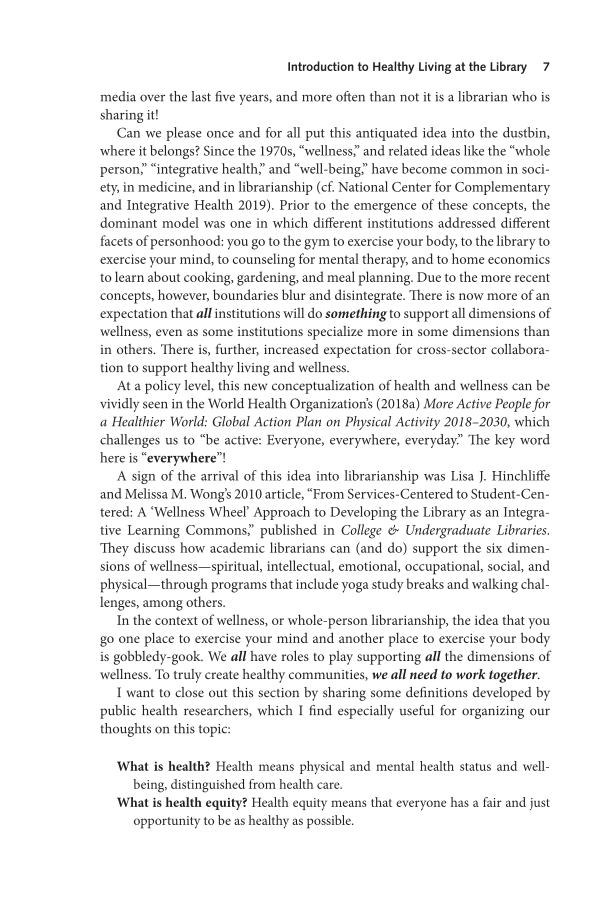Introduction to Healthy Living at the Library 7 media over the last five years, and more often than not it is a librarian who is sharing it! Can we please once and for all put this antiquated idea into the dustbin, where it belongs? Since the 1970s, “wellness,” and related ideas like the “whole person,” “integrative health,” and “well-being,” have become common in soci- ety, in medicine, and in librarianship (cf. National Center for Complementary and Integrative Health 2019). Prior to the emergence of these concepts, the dominant model was one in which different institutions addressed different facets of personhood: you go to the gym to exercise your body, to the library to exercise your mind, to counseling for mental therapy, and to home economics to learn about cooking, gardening, and meal planning. Due to the more recent concepts, however, boundaries blur and disintegrate. There is now more of an expectation that all institutions will do something to support all dimensions of wellness, even as some institutions specialize more in some dimensions than in others. There is, further, increased expectation for cross-sector collabora- tion to support healthy living and wellness. At a policy level, this new conceptualization of health and wellness can be vividly seen in the World Health Organization’s (2018a) More Active People for a Healthier World: Global Action Plan on Physical Activity 2018–2030, which challenges us to “be active: Everyone, everywhere, everyday.” The key word here is “everywhere”! A sign of the arrival of this idea into librarianship was Lisa J. Hinchliffe and Melissa M. Wong’s 2010 article, “From Services-Centered to Student-Cen- tered: A ‘Wellness Wheel’ Approach to Developing the Library as an Integra- tive Learning Commons,” published in College & Undergraduate Libraries. They discuss how academic librarians can (and do) support the six dimen- sions of wellness—spiritual, intellectual, emotional, occupational, social, and physical—through programs that include yoga study breaks and walking chal- lenges, among others. In the context of wellness, or whole-person librarianship, the idea that you go one place to exercise your mind and another place to exercise your body is gobbledy-gook. We all have roles to play supporting all the dimensions of wellness. To truly create healthy communities, we all need to work together. I want to close out this section by sharing some definitions developed by public health researchers, which I find especially useful for organizing our thoughts on this topic: What is health? Health means physical and mental health status and well- being, distinguished from health care. What is health equity? Health equity means that everyone has a fair and just opportunity to be as healthy as possible.
Document Details My Account Print multiple pages
Print
You have printed 0 times in the last 24 hours.
Your print count will reset on at .
You may print 0 more time(s) before then.
You may print a maximum of 0 pages at a time.










































































































































































































































